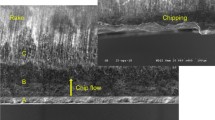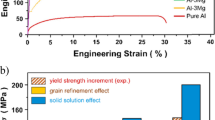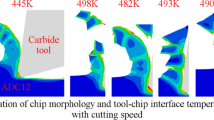Abstract
Due to the sticky and soft characteristics of aluminum alloy, it is easy to form adhesion on the tool rake face during cutting process. In this work, the orthogonal cutting tests for 6061-T6 aluminum were carried out at cutting speeds of 20–300 m/min and feed rates of 0.05–0.3 mm, and the relationship between adhesion and cutting force has been explored. A slip-line model was used to separate the edge force of cutting edge to obtain the pure friction force of tool rake face, thereby obtaining the average friction coefficient. Adhesion morphologies were observed under the scanning electron microscope (SEM) and compared with the average friction coefficients. It was found that different adhesion morphologies correspond to different friction coefficient ranges. Simultaneously, the relationship between the temperature and normal stress on the tool rake face and the adhesion morphology and friction coefficient was investigated. The results showed that the temperature is the major factor of adhesion evolution and friction coefficient change. Combining the tool rake face temperature and the adhesion morphology, it was noted that the reduction of the friction coefficient is not only owing to the self-lubrication caused by thermal softening, but also due to the decrease of the total shear force caused by the incomplete contact. Finally, the relationship between the friction coefficient of tool rake face and the cutting force and specific cutting energy was discussed, with the conclusion that the friction coefficient has an impact on the cutting force and specific cutting energy by changing the shear angle.
























Similar content being viewed by others
References
Stewart VA, Brown RH (1973) The Interrelationship of Shear and Friction Processes in Machining Under Regenerative Chatter Conditions. Macmillan Education UK
Childs T (2006) Friction modelling in metal cutting. Wear 260(3):310–318. https://doi.org/10.1016/j.wear.2005.01.052
Ozlu E, Budak E, Molinari A (2009) Analytical and experimental investigation of rake contact and friction behavior in metal cutting. Int J Mach Tools Manuf 49(11):865–875. https://doi.org/10.1016/j.ijmachtools.2009.05.005
Behera BC, Ghosh S, Paruchuri VR (2017) Modeling of cutting force in MQL machining environment considering chip tool contact friction. Tribol Int 117:283–295. https://doi.org/10.1016/j.triboint.2017.09.015
Smolenicki D, Boos J, Kuster F, Roelofs H, Wyen CF (2014) In-process measurement of friction coefficient in orthogonal cutting. CIRP Ann 63(1):97–100. https://doi.org/10.1016/j.cirp.2014.03.083
Rech J, Arrazola PJ, Claudin C, Courbon C, Pusavec F, Kopac J (2013) Characterisation of friction and heat partition coefficients at the tool-work material interface in cutting. CIRP Ann Manuf Technol 62(1):79–82. https://doi.org/10.1016/j.cirp.2013.03.099
Puls H, Klocke F, Lung D (2014) Experimental investigation on friction under metal cutting conditions. Wear 310(1–2):63–71. https://doi.org/10.1016/j.wear.2013.12.020
Peng B, Bergs T, Schraknepper D, Smigielski T, Klocke F (2020) Development and validation of a new friction model for cutting processes. Int J Adv Manuf Technol 107(4):1–13. https://doi.org/10.1007/s00170-019-04709-8
Klocke F, Trauth D, Shirobokov A, Mattfeld P (2015) FE-analysis and in situ visualization of pressure-, slip-rate-, and temperature-dependent coefficients of friction for advanced sheet metal forming: development of a novel coupled user subroutine for shell and continuum discretization. Int J Adv Manuf Technol 81(1–4):397–410. https://doi.org/10.1007/s00170-015-7184-1
Song XQ, Takahashi Y, He WM, Ihara T (2017) On the formation mechanisms of adhering layer during machining metal material. Key Eng Mater 749:39–45. https://doi.org/10.4028/www.scientific.net/KEM.749.39
Gomez-Parra A, Alvarez-Alcon M, Salguero J, Batista M, MarcosM, (2013) Analysis of the evolution of the built-up edge and built-up layer formation mechanisms in the dry turning of aeronautical aluminium alloys. Wear 302(1–2):1209–1218. https://doi.org/10.1016/j.wear.2012.12.001
Batista SD, Gomez-Parra A, Ramirez-Pea M, Salguero J (2019) Study of the tool wear process in the dry turning of al–cu alloy. Metals 9(10):1094. https://doi.org/10.20944/preprints201909.0253.v1
Bahi S, Nouari M, Moufki A, Mansori ME, Molinari A (2011) A new friction law for sticking and sliding contacts in machining. Tribol Int 44(7):764–771
Molinari A, Cheriguene R, Miguelez H (2011) Numerical and analytical modeling of orthogonal cutting: the link between local variables and global contact characteristics. Int J Mech Sci 53(3):183–206. https://doi.org/10.1016/j.triboint.2011.01.007
Albrecht P (1960) New developments in the theory of the metal-cutting process: part I the ploughing process in metal cutting. Journal of Engineering for Industry 82(4):348. https://doi.org/10.1115/1.3664242
Guo YB, Chou YK (2004) The determination of ploughing force and its influence on material properties in metal cutting. J Mater Process Technol 148(3):368–375. https://doi.org/10.1016/j.jmatprotec.2004.02.052
Seif CY, Hage IS, Hamade RF (2021) Extracting HCP zerilli-armstrong material parameters for magnesium alloy az31b from orthogonal cutting tests. J Mater Process Technol 290:116982. https://doi.org/10.1016/j.jmatprotec.2020.116982
Stevenson R (1998) The measurement of parasitic forces in orthogonal cutting. Int J Mach Tools Manuf 38(1–2):113–130. https://doi.org/10.1016/s0890-6955(97)00022-9
Popov A, Dugin A (2013) A comparison of experimental estimation methods of the ploughing force in orthogonal cutting. Int J Mach Tools Manuf 65:37–40. https://doi.org/10.1016/j.ijmachtools.2012.09.003
Waldorf DJ, Devor RE, Kapoor SG (1998) A slip-line field for ploughing during orthogonal cutting. J Manuf Sci Eng 120(4):693–699. https://doi.org/10.1115/1.2830208
Fang N, Fang G (2007) Theoretical and experimental investigations of finish machining with a rounded edge tool. J Mater Process Technol 191(1–3):331–334. https://doi.org/10.1016/j.jmatprotec.2007.03.060
Jin X, Altintas Y (2011) Slip-line field model of micro-cutting process with round tool edge effect. J Mater Process Technol 211(3):339–355. https://doi.org/10.1016/j.jmatprotec.2010.10.006
Zhou T, Lin H, Zou Z (2020) Three-dimensional turning force prediction based on hybrid finite element and predictive machining theory considering edge radius and nose radius. J Manuf Process 58:1304–1317. https://doi.org/10.1016/j.jmapro.2020.09.034
Malekian M, Mostofa MG, Park SS, Jun M (2012) Modeling of minimum uncut chip thickness in micro machining of aluminum. J Mater Process Technol 212(3):553–559. https://doi.org/10.1016/j.jmatprotec.2011.05.022
Karpat Y, Ozel T (2005) Predictive analytical and thermal modeling of orthogonal cutting process—part I: predictions of tool forces, stresses, and temperature distributions. J Manuf Sci Eng 128(2):435–444. https://doi.org/10.1115/1.2162590
Hong SY, Ding YC, Jeong W (2001) Friction and cutting forces in cryogenic machining of ti–6al–4v. Int J Mach Tools Manuf 41:2271–2285. https://doi.org/10.1016/S0890-6955(01)00029-3
Bencheikh I, Nouari M, Bilteryst F (2020) Multi-step simulation of multi-coated tool wear using the coupled approach XFEM/multi-Level-set. Tribol Int 146:106304. https://doi.org/10.1016/j.triboint.2019.106034
Courbon C, Mabrouki T, Rech J, Mazuyer D, D’Eramo E (2013) On the existence of a thermal contact resistance at the tool-chip interface in dry cutting of AISI 1045: formation mechanisms and influence on the cutting process. Appl Therm Eng 50(1):1311–1325. https://doi.org/10.1016/j.applthermaleng.2012.06.047
Grzesik W, Nieslony P (2004) Physics based modelling of interface temperatures in machining with multilayer coated tools at moderate cutting speeds. Int J Mach Tools Manuf 44(9):889–901. https://doi.org/10.1016/j.ijmachtools.2004.02.014
Grzesik W, Bartoszuk M, Nieslony P (2004) Finite difference analysis of the thermal behavior of coated tools in orthogonal cutting of steels. Int J Mach Tools Manuf 44(14):1451–1462. https://doi.org/10.1016/j.ijmachtools.2004.05.008
Grzesik W, Luttervelt CA (2005) Analytical models based on composite layer for computation of tool-chip interface temperatures in machining steels with multilayer coated cutting tools. CIRP Ann Manuf Technol 54(1):91–94. https://doi.org/10.1016/S0007-8506(07)60057-2
Liu Y, Gong Y, Liu W, Sun X, Xu L (2020) Effect of milling parameters on chip shape and chip morphology for Zr-based bulk metallic glass by using micro-groove milling. Int J Adv Manuf Technol 111:1587–1602. https://doi.org/10.1007/s00170-020-06164-2
Moufki A, Molinari A, Dudzinski D (1998) Modelling of orthogonal cutting with a temperature dependent friction law. J Mech Phys Solids 46(10):2103–2138. https://doi.org/10.1016/S0022-5096(98)00032-5
Zhou L, Peng FY, Yan R, Yao PF, Yang CC, Li B (2015) Analytical modeling and experimental validation of micro end-milling cutting forces considering edge radius and material strengthening effects. Int J Mach Tools Manuf 97:29–41. https://doi.org/10.1016/j.ijmachtools.2015.07.001
Atkins T (2015) Prediction of sticking and sliding lengths on the rake faces of tools using cutting forces. Int J Mech Sci 91:33–45. https://doi.org/10.1016/j.ijmecsci.2014.06.004
Zaghbani I, Songmene V (2009) A force-temperature model including a constitutive law for dry high speed milling of aluminum alloys. J Mater Process Technol 209(5):2532–2544. https://doi.org/10.1016/j.jmatprotec.2008.05.050
Shaw MC (2005) Metal cutting principles. Oxford University Press, New York
Chetan GS, Rao PV (2018) Specific cutting energy modeling for turning nickel-based Nimonic 90 alloy under MQL condition. Int J Mech Sci 146–147:25–38. https://doi.org/10.1016/j.ijmecsci.2018.07.033
Funding
This work is supported by Natural Science Foundation of Fujian Province (Grant No. 2019J01212), National Natural Science Foundation of China (Grant No. 51975123), Science and Technology Plan Project of Fuzhou(Grant No. 2018-G-57), Fuzhou University Talent Fund(Grant No. XRC-18003).
Author information
Authors and Affiliations
Contributions
Jianchao Yu contributed to the conception of the study; Yuxing Ding performed the experiment, contributed significantly to analysis and manuscript preparation, performed the data analyses, and wrote the manuscript; Zhikai Lu assisted the experiment.
Corresponding author
Ethics declarations
Ethics approval
The manuscript has not been submitted or published anywhere. It will not be submitted elsewhere as well.
Consent to participate
All authors consent to participate in the author team of this submitted manuscript.
Consent to publish
The manuscript was approved by all authors to publish.
Competing interests
The authors declare no competing interests.
Additional information
Publisher's note
Springer Nature remains neutral with regard to jurisdictional claims in published maps and institutional affiliations.
Rights and permissions
Springer Nature or its licensor (e.g. a society or other partner) holds exclusive rights to this article under a publishing agreement with the author(s) or other rightsholder(s); author self-archiving of the accepted manuscript version of this article is solely governed by the terms of such publishing agreement and applicable law.
About this article
Cite this article
Ding, Y., Yu, J. & Lu, Z. The relationship between adhesion morphology and cutting force in orthogonal cutting of 6061-T6 aluminum alloy. Int J Adv Manuf Technol 124, 1971–1991 (2023). https://doi.org/10.1007/s00170-022-10591-8
Received:
Accepted:
Published:
Issue Date:
DOI: https://doi.org/10.1007/s00170-022-10591-8




